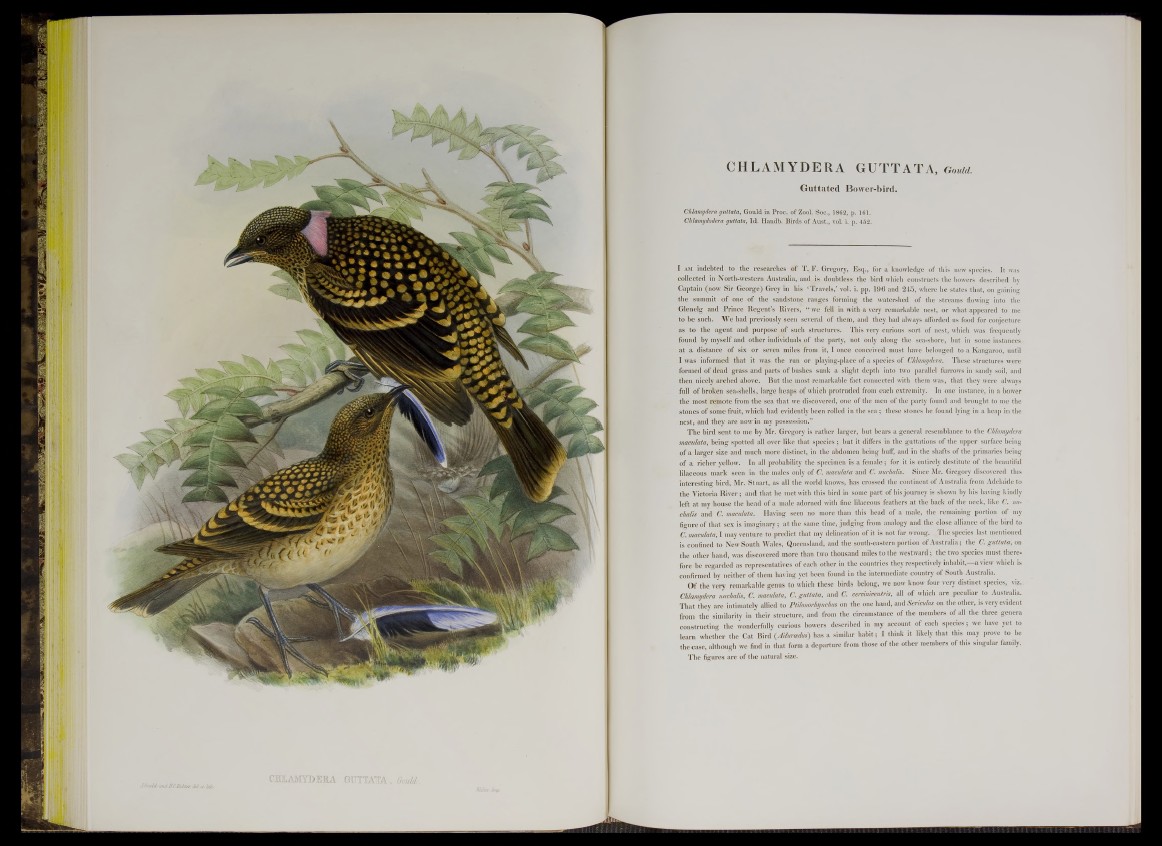
CHLAMYDERA GUTTA T A, Gould.
Guttated Bower-bird.
Chlamydera guttata, Gould in Proc. of Zool. Soe., 1862, p. 161.
Chlamydodera guttata, Id. Handb. Birds of Aust., vol. i. p. 452.
I am indebted to the researches of T , F. Gregory, Esq., for a knowledge of this new species. It was
collected in North-western Australia, and is doubtless the bird which constructs the bowers described by
Captain (now Sir George) Grey in his ‘ Travels,’ vol. i. pp. 196 and 245, where he states that, on gaining
the summit of one of the sandstone ranges forming the watershed of the streams flowing into the
Glenelg and Prince Regent’s Rivers, “ we fell in with a very remarkable nest, or what appeared to me
to be such. We had previously seeu several of them, and they had always afforded us food for conjecture
as to the agent and purpose of such structures. This very curious sort of nest, which was frequently
found by myself and other individuals of the party, not only along the sea-shore, but in some instances
at a distance of six or seven miles from it, I once conceived must have belonged to a Kangaroo, until
I was informed that it was the run or playing-place of a species of Chlamydera. These structures were
formed of dead grass and parts of bushes sunk a slight depth into two parallel furrows in sandy soil, and
then nicely arched above. But the most remarkable fact connected with them was, that they were always
full of broken sea-shells, large heaps of which protruded from each extremity. In one instance, in a bower
the most remote from the sea that we discovered, one of the men of the party found and brought to me the
stones of some fruit, which had evidently been rolled in the sea ; these stones he found lying in a heap in the
nest, and they are now in my possession.”
The bird sent to me by Mr. Gregory is rather larger, but bears a general resemblance to the Chlamydera
maculata, being spotted all over like that species ; but it differs in the guttations of the upper surface being
of a larger size and much more distinct, in the abdomen being buff, and in the shafts of the primaries being
of a richer yellow. In all probability the specimen is a female; for it is entirely destitute of the beautiful
lilaceous mark seen in the males only of C. maculata and C. nuchalis. Since Mr. Gregory discovered this
interesting bird, Mr. Stuart, as all the world knows, has crossed the continent of Australia from Adelaide to
the Victoria River; and that he met with this bird in some part of his journey is shown by his having kindly
left at my house the head of a male adorned with fine lilaceous feathers at the back of the neck, like C. nu-
chalis and C. maculata. Having seen no more than this head of a male, the remaining portion of my
figure of that sex is imao-iuary; at the same time, judging from analogy and the close alliance of the bird to
C. maculata, I may venture to predict that my delineation of it is not far wrong. The species last mentioned
is confined to New South Wales, Queensland, and the south-eastern portion of Australia; the C. guttata, on
the other hand, was discovered more than two thousand miles to the westward; the two species must therefore
be regarded as representatives of each other in the countries they respectively inhabit,—a view which is
confirmed by neither of them having yet been found in the intermediate country of South Australia.
Of the very remarkable genus to which these birds belong, we now know four very distinct species, viz..
Chlamydera nuchalis, C. maculata, C. guttata, and C. cerviniventris, all of which are peculiar to Australia.
That they are intimately allied to Ptilonorhynchus on the one hand, and Sericulus on the other, is very evident
from the similarity in their structure, and from the circumstance of the members of all the three genera
constructing the wonderfully curious bowers described in my account of each species; we have yet to
learn whether the Cat Bird (Ailurcedus) has a similar habit; I think it likely that this may prove to be
the case, although we find in that form a departure from those of the other members of this singular family.
The figures are of the natural size.